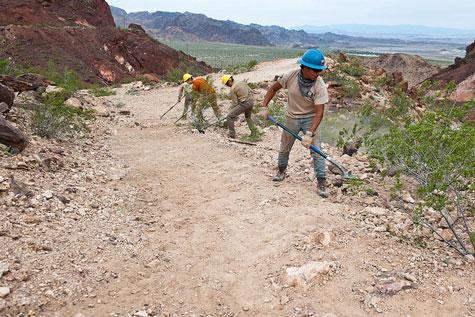A popular hike at Lake Mead National Recreation Area follows a former railroad grade associated with the construction of Hoover Dam in the 1930s. Thanks to work by a youth trail crew, visitors now have an additional option for accessing the Historic Railroad Trail: a 0.3-mile spur connecting the Railroad Trail to the Hoover Dam Lodge parking area.
The crew, from the Arizona Conservation Corps, worked on the trail for three weeks in March. The new path, a former unofficial "social trail," has now been greatly improved with new gravel on a better defined route; benches have also been installed along the new trail.
Visitors who want to hike the Historic Railroad trail can now choose to park in the Hoover Dam Lodge parking lot off of Highway 93, near mile marker 2.5. From there, it's 0.3-miles on the new spur trail to the main Railroad Trail.
The Historic Railroad Trail follows 3.7 miles of historic railroad bed from another trailhead near the Alan Bible Visitor Center to Hoover Dam. This flat, easy trail passes through five tunnels on its way to the dam. You'll find a map showing the route and surrounding area at this link.
The popular hike offers fine desert scenery, a chance to spot wildlife, including desert Bighorn sheep, and some interesting history.
The railroad was built in 1931 to transport supplies during the construction of Hoover Dam, and the route includes five impressive tunnels, each of which is about 300 feet long and 25 feet in diameter. The tunnels were oversized to fit penstock sections and large equipment being transported to the dam.
According to a park publication, 71 people used nine steam and four gas locomotives in the operations of the railroad. It was built using a standard-gauge, 90-pound rail construction, which refers to the weight of one yard of rail. The ties were Oregon fir. The last use of the railroad was in 1961, and the following year, the tracks were dismantled and sold for scrap.
The former railroad grade was largely abandoned until the 1990s, when grant money was used to stabilize the tunnels and smooth the grade to make it more suitable for foot traffic. The first section of the trail opened for use by hikers in 1995.
Last month's work on the spur connection was funded through a $15,000 grant from the National Fish & Wildlife Foundation, in partnership with the Bureau of Reclamation and National Park Service.
If you'd like to hike the Historic Railroad Trail, or other foot routes in the park, the best time of the year is in the spring and fall; summer weather is normally very hot and dry. You'll find more information about hiking at Lake Mead NRA on the park website.




Add comment